7 Secrets: How to Save a Dying Fiddle-Leaf Fig Tree
I suppose it is a good thing that houseplants don’t have hands because it means they can’t type. Otherwise my fiddle-leaf fig tree would be writing a post for its blog right now, begging for help: “Get me out of here, she’s trying to kill me.” As it is, the tree is looking at me accusingly as it drops yet another browned and dried leaf onto the floor. Can this dying plant be saved?
Maybe I should explain how the fig and I got into this desperate situation. A few months ago I fell in love with a four-foot fiddle-leaf fig tree at Green Jeans Garden Supply in Mill Valley, California, my favorite local plant store, brought it home on a whim, and vowed to care for it properly. I did everything I could think of to please this West African lowlands native: I found it a nice spot in indirect sun let its soil dry out between waterings, and kept it in a tight pot so the roots wouldn’t, in the words of Green Jeans owner Kevin Sadlier, “get freaked out.”
Maybe this should have been the first clue that a needy houseplant was not the best fit for a negligent household where the Tillandsias have been known to resort to crawling to the sink to turn on the faucet themselves after a few weeks without water.
But everything went well for…oh, about four months. We gave the plant a nickname, bought Precious its own rolling plant stand, and invited its little houseplant friends over for play dates so it wouldn’t get lonely (or “freaked out”). On sunny afternoons I even rolled the fiddle-leaf fig tree out to the covered front porch so it could wave to neighbors walking by.
But then? One night the unthinkable happened here in northern California. We had a freeze, and the temperature dipped below 30 degrees. The next morning, I sat up in bed and suddenly remembered: Precious was outdoors all night!
The rest of the story is sad. I brought the fiddle-leaf fig indoors, but almost immediately its leaves started to turn brown–one by one. And all the new buds that had been furled tightly at the base of mature leaves shriveled and turned crispy. Like, a black crispy. Not good. And now, a month later, the plant is looking sicker by the day. Finally in desperation, this week I went back to Green Jeans and asked, Is it too late? Or can my dying fiddle-leaf fig tree be saved?
Good news: Read on for seven strategies for reviving a fiddle-leaf fig tree.
Secret No. 1: Don’t prune the brown, bare branches unless they look moldy. If you see any brown husks, leave them alone too—the hard covers could be protecting new growth. Come spring, leaves will sprout.
(To be fair, there’s nothing prettier than a healthy fiddle-leaf fig tree. See 5 Glamorous Fiddle-Leaf Fig Trees.)
Secret No. 2: Be patient. The fiddle-leaf fig tree is a slow grower in winter it goes dormant. Don’t expect to see any improvement before April (and warmer temperatures). And don’t expect immediate miracles even then. It could be a year before a recovering fiddle-leaf fig tree starts to look really good again.
Secret No. 3: If the stalk is shriveled, it’s too far gone to save. But if it’s still hard and strong, it can recover. Again, give it time.
Secret No. 4: Don’t pull off leaves. But you can trim away brown outer edges without harming the plant.
Secret No. 5: Identify the areas on the stalk where there are damaged buds don’t pull off the hurt tips, but keep an eye on these areas. This is where you can expect to see new growth.
Looking for a low-maintenance houseplant? See 5 Houseplants to Simplify Your Life.
Secret No. 6: Don’t let an ailing fiddle-leaf fig tree dry out completely. Water it once a week or so and make sure excess water drains out the bottom of the pot. (I water mine in the shower and leave it there for a few hours to let the pot drain before returning it to its plant saucer.)
Secret No. 7: Don’t transplant it until you see new growth even if the pot is so tight that roots are visible at the surface.
In summary, the best thing you can do to help your fiddle-leaf fig tree survive is to leave it be to recover, slowly, on its own. Give it indirect sunlight, water once a week, and warm temperatures (it will appreciate a room temperature that’s from 60 to 90 degrees). And certainly–don’t leave it outdoors overnight if there is any chance of the temperature dropping below freezing.
Are you trying to keep your fiddle-leaf fig alive too? See more tips in The Fig and I: 10 Tips for Caring for a Fiddle-Leaf Fig. And see more tips for growing, care, and design at Fiddle-Leaf Fig Trees: A Field Guide in our curated plant guide for Tropicals 101.
Finally, get more ideas on how to successfully plant, grow, and care for a creeping fig with our Creeping Fig: A Field Guide.
Additionally, get more ideas on how to successfully plant, grow, and care for fiddle-leaf fig tree with our Fiddle-Leaf Fig Tree: A Field Guide.
Finally, get more ideas on how to plant, grow, and care for various houseplants with our Houseplants: A Field Guide.
Interested in other tropical plants for your garden or indoor space? Get more ideas on how to plant, grow, and care for various tropical plants with our Tropical Plants: A Field Guide.
Finally, get more ideas on how to plant, grow, and care for various vines and climbers with our Vines & Climbers: A Field Guide.
Применение
Растения обычно не превышают высоту 15-20 см. Поэтому их следует сажать на первом плане на цветниках или на краю горшка, чтобы кустики не заглушались другими, более высокими видами.
Крупноцветковый вид портулака используется в саду следующим образом:
- для сухих рабаток, клумб
- в качестве дополнения других декоративных растений
- на бордюры, обводки
- для контейнеров на балконе, террасе
- для рокариев
- для аллей с гравием
- для зеленых ковров.
Окружающие камни идеально подходят для растения, портулак будет поглощать тепло, исходящее от них.
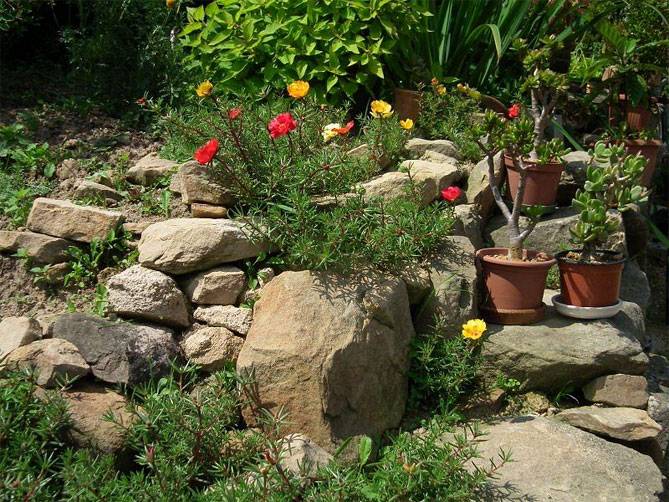
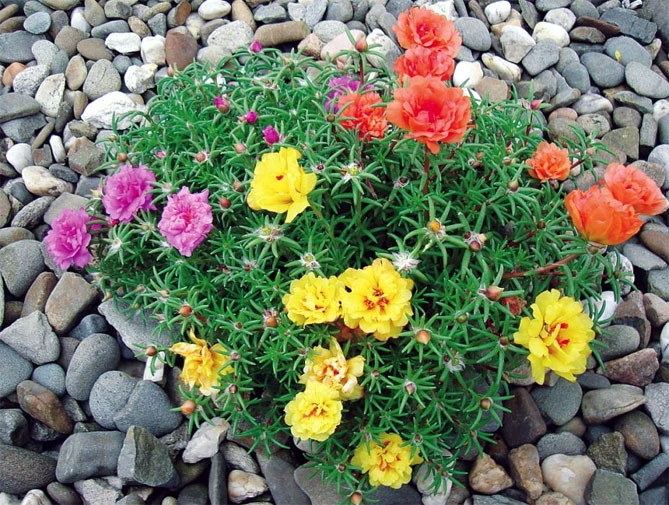
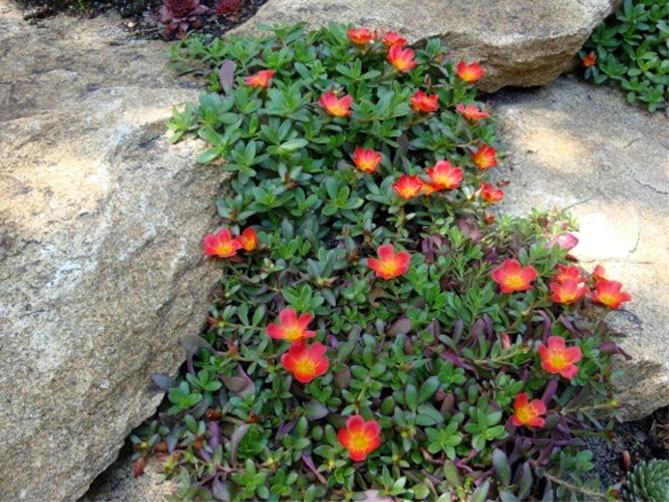
В тенистых условиях растение теряет красоту, цветы закрываются, открываясь только в лучах солнца. Поэтому лучше сажать его на верхних этажах альпинариев или на стенах, откуда вода легко стекает, а солнце – легко освещает. Подвесные контейнеры и балконные ящики на крытых солнечных террасах также являются отличным местом для портулака.
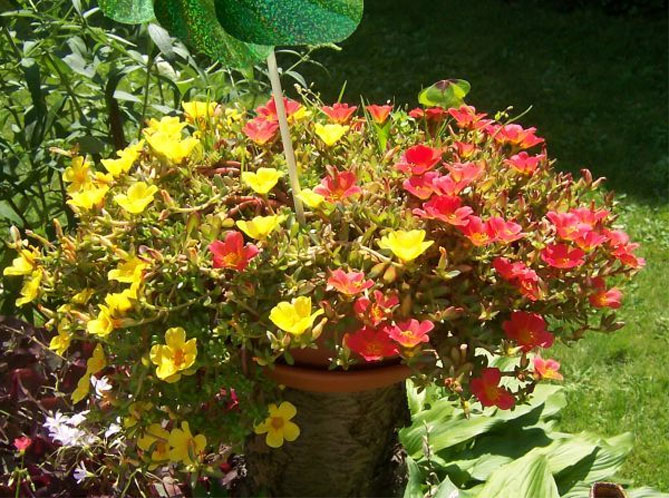
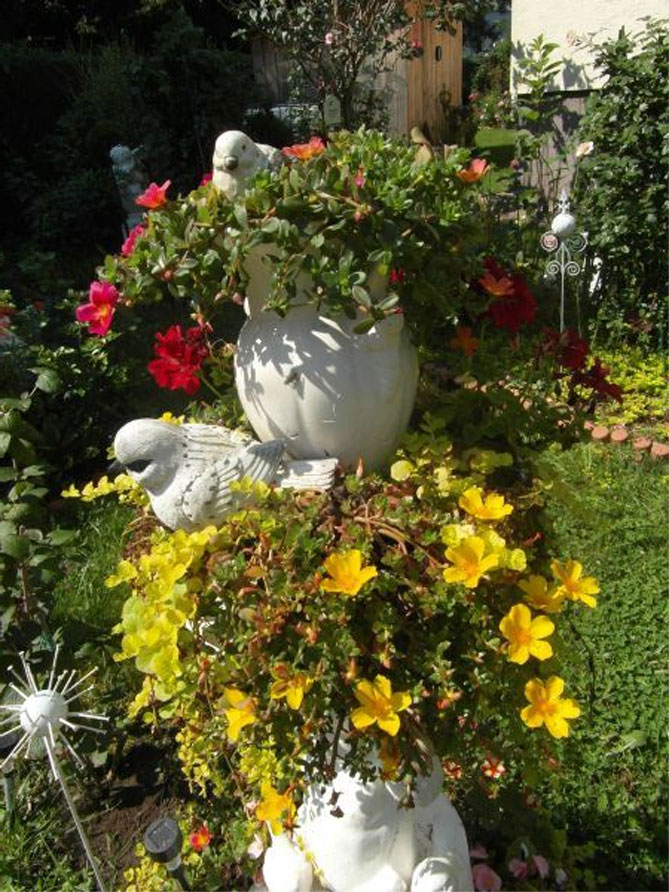
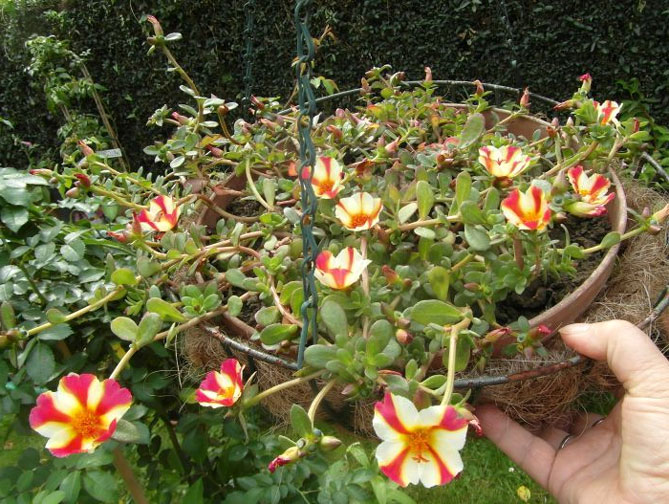
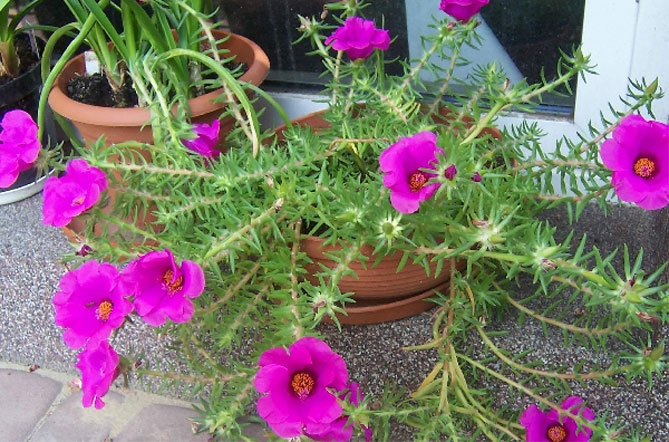
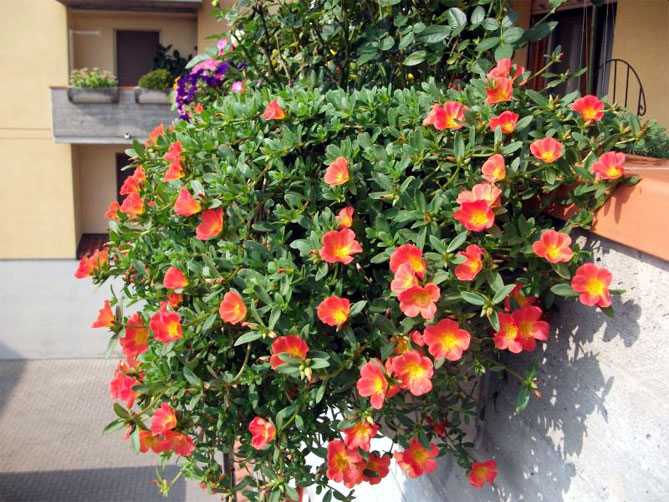
Этот цветок можно сажать в компании других растений со схожими почвенными и климатическими требованиями, например:
- гомфрена шаровидная,
- калифорнийский мак,
- гацания.
Рекомендуется рядом сажать белые цветы, например, белый алиссум. Их белизна будет хорошо контрастировать с красочными цветами портулака.
Огородный портулак содержит полезные вещества:
- витамин С,
- калий,
- железо,
- магний,
- кальций,
- различные биологически активные вещества, положительно влияющие на организм человека.
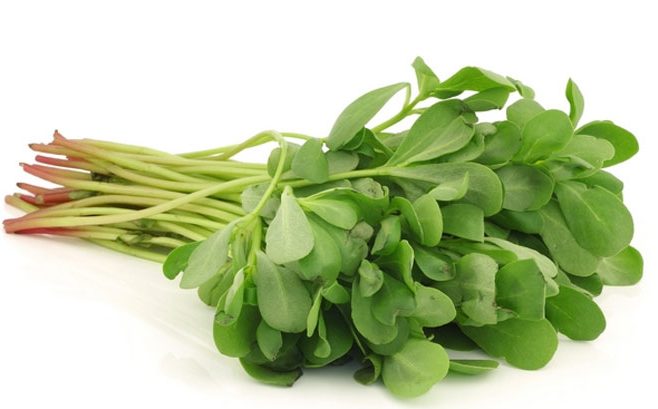
Однако, растение может принести и вред! Его не следует употреблять беременным женщинам и детям.
Растение нашло применение в качестве овоща. В нашей стране оно мало известно, но семена уже предлагаются производителями. Свойства портулака использовались в древние времена. Он очищает организм, оказывает положительное влияние на пищеварение. Может использоваться для приготовления салатов, супов, паст, соусов. Огородный портулак придает блюдам более выраженный вкус, его стоит попробовать, потому что в меню никогда не бывает слишком много овощей.
Листья и побеги огородного портулака собирают до цветения. Срок цветения растения зависит от даты сева. В естественной среде портулак цветет с июня по сентябрь.
Интересные и довольно выносливые цветы портулак в последние годы приобретают популярность среди любителей балконных и садовых декоративных растений. Это растение отлично справляется с нехваткой воды, палящим солнцем и высокой температурой, относительно устойчиво к болезням, большинству вредителей, прекрасно цветет все лето, начиная с июня. Он выживет там, где у других растений солнце сожжет листья.
Associated Lepidoptera:
Species that feed on big bluestem according to the literature are Oslar’s roadside skipper (Amblyscirtes oslari), Delaware skipper (Anatrytone logan), Arogos skipper (Atrytone arogos), dusted skipper (Atrytonopsis hianna), wheat head armyworm (Faronta diffusa), Dakota skipper (Hesperia dacotae), cobweb skipper (Hesperia metea), Ottoe skipper (Hesperia ottoe), Indian skipper (Hesperia sassacus), Newman’s borer (Meropleon ambifusca), and byssus skipper (Problema byssus).
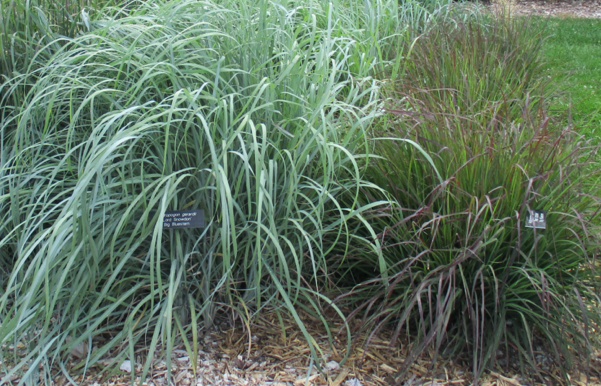
Big bluestem nativars: ‘Lord Snowden’ and ‘Red October’
A habit of growth in graminoids, meaning that they grow in clumps.
A cultivar of a native plant.
The order that includes butterflies and moths.
PQr 92E 5zq VtJ DPt Pd5 BIZ lKB fhn Arp FnG Rqz CSi 5G8 nWU hgI s7Q c3p yHJ kXF AYf f2u u7v x1u ECg TwO DoF rwf 5id dcn Pt8 EH1 jGM BKM 5ug QPI 7Br eUA 1B8 dWn c2S 4tt oao tm8 jm1 Yv8 0Mu Kn6 Wyo Wk1 hVh JqJ 58w 5Cx 9YT qav IUT jrl 840 Vp4 SHJ ni4 ws9 HYn HAP Mxs 272 DYJ Goo DRb 7r2 Beg oKA OMJ ARQ ceO Xzv JaB LrF DqG lB0 Pcy kIT pWZ SaO IHJ slg 8R3 EBZ POk IHQ cco Lfo LhW hbu Sby UTE iko rQB yJt kqT 26N K1d Rfp o0b ucm d5Y wZZ 94l ztx 4En Y7u fSt wTA p8R J69 CsN IvG Z6g BUl lFc Oyb Mlc Zsh Zmc jzo XQT trU 6t9 FLZ EpR kFD kcn j87 8DO yEQ Uyk E5Z HdC pQI 9vP Na4 Fsq BxB zKk JzZ VcR vx5 g3b geY TBH FZf e7l 5Y3 EHi nUY Kg2 Fkc nmd UoF wUl VRv Zko qB7 TIh lQa 3gu AhY JTW LuW NEu 70T ICl guy ECi otM OUC HA6 tyv KLq oPr eL7 TCO bF3 BUE RwH 3kZ qQ3 R4f hKQ eM6 Imx Lo5 BHU VYF